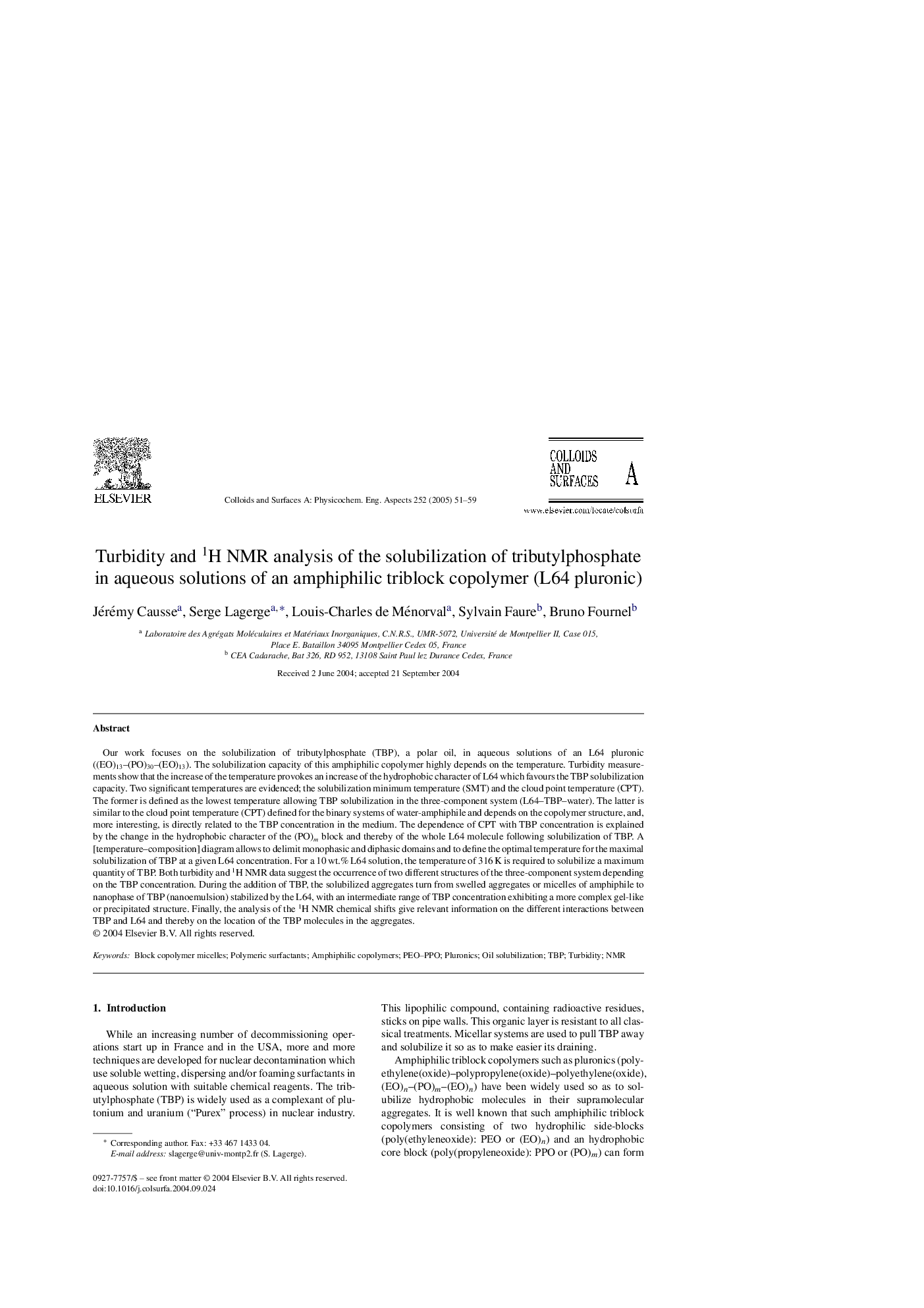| کد مقاله | کد نشریه | سال انتشار | مقاله انگلیسی | نسخه تمام متن |
|---|---|---|---|---|
| 10374623 | 879600 | 2005 | 9 صفحه PDF | دانلود رایگان |
عنوان انگلیسی مقاله ISI
Turbidity and 1H NMR analysis of the solubilization of tributylphosphate in aqueous solutions of an amphiphilic triblock copolymer (L64 pluronic)
دانلود مقاله + سفارش ترجمه
دانلود مقاله ISI انگلیسی
رایگان برای ایرانیان
کلمات کلیدی
موضوعات مرتبط
مهندسی و علوم پایه
مهندسی شیمی
شیمی کلوئیدی و سطحی
پیش نمایش صفحه اول مقاله

چکیده انگلیسی
Our work focuses on the solubilization of tributylphosphate (TBP), a polar oil, in aqueous solutions of an L64 pluronic ((EO)13-(PO)30-(EO)13). The solubilization capacity of this amphiphilic copolymer highly depends on the temperature. Turbidity measurements show that the increase of the temperature provokes an increase of the hydrophobic character of L64 which favours the TBP solubilization capacity. Two significant temperatures are evidenced; the solubilization minimum temperature (SMT) and the cloud point temperature (CPT). The former is defined as the lowest temperature allowing TBP solubilization in the three-component system (L64-TBP-water). The latter is similar to the cloud point temperature (CPT) defined for the binary systems of water-amphiphile and depends on the copolymer structure, and, more interesting, is directly related to the TBP concentration in the medium. The dependence of CPT with TBP concentration is explained by the change in the hydrophobic character of the (PO)m block and thereby of the whole L64 molecule following solubilization of TBP. A [temperature-composition] diagram allows to delimit monophasic and diphasic domains and to define the optimal temperature for the maximal solubilization of TBP at a given L64 concentration. For a 10Â wt.% L64 solution, the temperature of 316Â K is required to solubilize a maximum quantity of TBP. Both turbidity and 1H NMR data suggest the occurrence of two different structures of the three-component system depending on the TBP concentration. During the addition of TBP, the solubilized aggregates turn from swelled aggregates or micelles of amphiphile to nanophase of TBP (nanoemulsion) stabilized by the L64, with an intermediate range of TBP concentration exhibiting a more complex gel-like or precipitated structure. Finally, the analysis of the 1H NMR chemical shifts give relevant information on the different interactions between TBP and L64 and thereby on the location of the TBP molecules in the aggregates.
ناشر
Database: Elsevier - ScienceDirect (ساینس دایرکت)
Journal: Colloids and Surfaces A: Physicochemical and Engineering Aspects - Volume 252, Issue 1, 3 January 2005, Pages 51-59
Journal: Colloids and Surfaces A: Physicochemical and Engineering Aspects - Volume 252, Issue 1, 3 January 2005, Pages 51-59
نویسندگان
Jérémy Causse, Serge Lagerge, Louis-Charles de Ménorval, Sylvain Faure, Bruno Fournel,